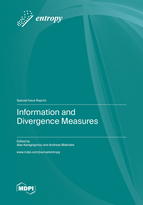Information and Divergence Measures
A special issue of Entropy (ISSN 1099-4300). This special issue belongs to the section "Information Theory, Probability and Statistics".
Deadline for manuscript submissions: closed (30 September 2022) | Viewed by 25530
Special Issue Editors
Interests: model selection; applied probability; reliability theory; medical statistics; time series; biostatistics
Special Issues, Collections and Topics in MDPI journals
Interests: stochastic modeling; stochastic processes; applied probability; mathematical statistics; semi-Markov processes; reliability theory; multi-state systems; entropy and divergence; goodness-of-fit tests; control charts–statistical quality control
Special Issue Information
Dear Colleagues,
The general topic of measures can be considered as a broad scientific area aiming to develop methods and techniques for inference and modelling of various phenomena in various scientific fields.
The concept of distance is important in establishing the degree of similarity and the degree of closeness among functions, populations, or distributions. As a result, distances are related to inferential statistics, including both estimation and hypothesis testing problems, and modelling with applications in regression analysis, multivariate analysis, actuarial science, portfolio optimization, survival analysis, reliability theory, and many more. Thus, the significant importance of entropy and divergence measures that emerges in many scientific fields makes such a topic of great interest to scientists, researchers, medical experts, engineers, industrial managers, computer experts, data analysts, etc.
This issue intents to cover the recent developments in Information and Divergence Measures and presents new theoretical issues that were not previously presented in the literature, as well as the solutions of important practical problems and case studies illustrating the application methodology.
The issue is expected to be a collective work by a number of leading scientists, (data) analysts, statisticians, mathematicians, computer scientists, information theory experts, and engineers who have been working on the front end of information theory and divergence measures.
All manuscripts in the issue are going to be written by leading researchers and practitioners in their respective fields of expertise and present a plethora of innovative methods, approaches, and solutions not covered before in the literature.
Prof. Dr. Alex Karagrigoriou
Dr. Andreas Makrides
Guest Editors
Manuscript Submission Information
Manuscripts should be submitted online at www.mdpi.com by registering and logging in to this website. Once you are registered, click here to go to the submission form. Manuscripts can be submitted until the deadline. All submissions that pass pre-check are peer-reviewed. Accepted papers will be published continuously in the journal (as soon as accepted) and will be listed together on the special issue website. Research articles, review articles as well as short communications are invited. For planned papers, a title and short abstract (about 100 words) can be sent to the Editorial Office for announcement on this website.
Submitted manuscripts should not have been published previously, nor be under consideration for publication elsewhere (except conference proceedings papers). All manuscripts are thoroughly refereed through a single-blind peer-review process. A guide for authors and other relevant information for submission of manuscripts is available on the Instructions for Authors page. Entropy is an international peer-reviewed open access monthly journal published by MDPI.
Please visit the Instructions for Authors page before submitting a manuscript. The Article Processing Charge (APC) for publication in this open access journal is 2600 CHF (Swiss Francs). Submitted papers should be well formatted and use good English. Authors may use MDPI's English editing service prior to publication or during author revisions.
Keywords
- entropy
- information theory
- divergence measures
- statistical inference
- survival analysis
- actuarial science
- multivariate analysis








